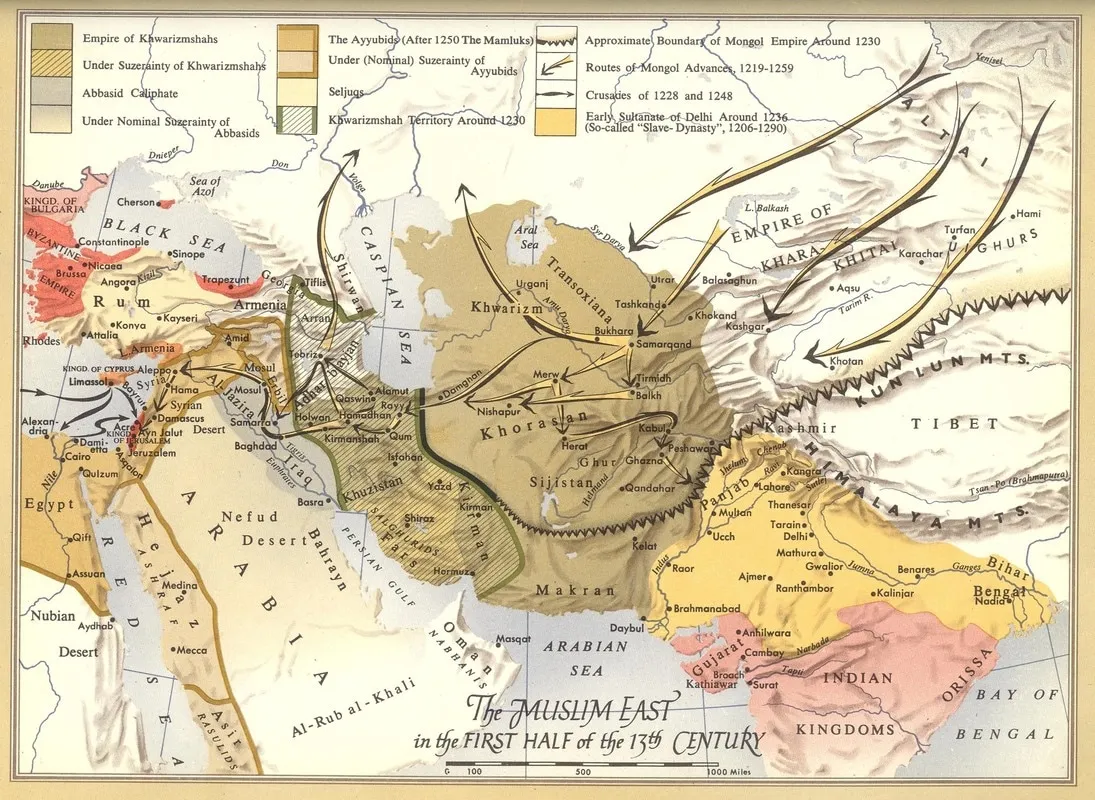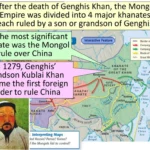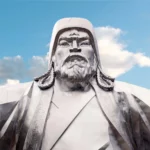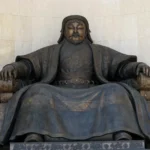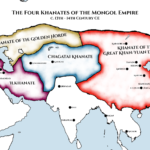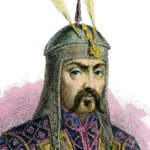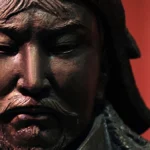In the 13th century, a whirlwind of change swept across Eurasia. Genghis Khan and his Mongol warriors galloped across vast lands, conquering everything in their path. His empire was like a giant chessboard, with the Khan moving his armies like pieces, shaping the history of the world as we know it. Join us on this epic journey to explore the conquests of Genghis Khan, a story of military might, clever diplomacy, and the rise and fall of civilizations.
Genghis Khan’s Epic Conquests: Uniting Tribes and Shaping History
Prepare for a wild ride through history, folks! Let’s dive into the thrilling tale of Genghis Khan, the legendary warrior who conquered vast territories and changed the world forever.
Uniting the Nomadic Clans
Back in the day, Mongolia was a land divided among nomadic tribes. Picture a tapestry of different tribes, each with their own leaders and customs. But Genghis Khan, a brilliant tactician, had a grand vision: to unite these tribes under one banner.
With his loyal followers by his side, Genghis Khan launched a series of strategic attacks. He used cunning tactics and brute force to subdue rival clans, including the Merkits, Tatars, and Keraites. Gradually, he stitched together a patchwork of tribes, creating a formidable force that would soon spread fear and awe across Asia.
The Asian Odyssey
Fueled by an insatiable hunger for conquest, Genghis Khan embarked on a series of lightning-fast campaigns. His armies surged across Asia like a raging storm, leaving a trail of shattered kingdoms and conquered lands.
From the plains of Mongolia, they pushed west, swallowing up vast territories in Central Asia. They reached as far as the Caspian Sea and the borders of Europe. To the east, they swept through China, conquering vast tracts of land that would later form the core of the Qing dynasty.
The Mongol Empire Takes Shape
Under Genghis Khan’s leadership and that of his successors, the Mongol Empire became a colossal entity. It stretched from the Pacific Ocean to the Carpathian Mountains, encompassing an area larger than the combined size of Europe and North America.
This immense empire not only conquered territories but also left an enduring legacy. The Mongols introduced new technologies, promoted trade, and established a system of communication and infrastructure that connected the far-flung regions of their realm.
The Impact of the Conquests
Genghis Khan’s conquests had a profound impact on world history. They reshaped political boundaries and cultural landscapes across Eurasia. The Mongol Empire became a melting pot of different ethnicities, religions, and ideas, fostering a unique blend of civilizations.
The rise and fall of the Mongol Empire is a testament to the power of military strategy, unity, and the indomitable spirit of a single leader. Genghis Khan’s legacy continues to inspire and captivate people to this day, reminding us of the transformative power of human ambition and the enduring impact of history’s greatest conquerors.
Curious about the great conqueror’s accomplishments? Genghis Khan achievements will reveal his remarkable conquests and legacy. Dive into the Genghis Khan timeline to trace his rise to power and the expansion of the Mongol Empire. Discover the profound impact of Genghis Khan and the Mongol Empire on world history. Finally, gain insights into the mind of this legendary figure through his Genghis Khan quotes.
The Enormous Mongol Empire: A Territory Unparalleled
Prepare to be awestruck by the sheer size of the Mongol Empire, a colossal entity that once dominated a whopping 24,000,000 square kilometers. Imagine an empire so vast that it could swallow up all of China, Russia, and Eastern Europe today!
This empire, conceived by the brilliant Genghis Khan, rose from the union of nomadic Mongolian tribes under his command. Through a combination of military prowess and political savvy, Genghis Khan embarked on a relentless campaign of conquest that would forever alter the face of Asia and the world.
The Mongol Empire in Numbers
- Area: 24,000,000 square kilometers
- Span: Pacific Ocean to the Danube River
- Founding: 1206 by Genghis Khan
Legacy and Significance
The Mongol Empire left an enduring mark on world history. Its vast extent facilitated cultural exchange and the spread of ideas across Eurasia. The empire also played a pivotal role in shaping the political landscape of the time and beyond.
How Did the Mongols Pull It Off?
- Military Genius: Genghis Khan and his generals were masters of strategy and tactics. They developed innovative tactics such as the use of composite bows and siege weaponry.
- Diplomatic Skills: The Mongols forged alliances with conquered territories, securing their loyalty through a combination of fear and respect.
- Postal System: The Mongols established an extensive network of horse-borne postal routes, enabling efficient communication across their vast empire.
The Mongols: More Than Just Conquerors
Beyond their military prowess, the Mongols also made significant contributions to civilization. They promoted religious tolerance, fostered the arts and sciences, and encouraged trade and commerce along the famed Silk Road.
A Human Touch
Imagine the thrill of riding across the boundless steppes, your horse galloping freely. The Mongol Empire was a testament to human ambition, determination, and the transformative power of leadership.
Tactics and Technologies Used by Genghis Khan
Imagine a man who rose from humble beginnings as a shepherd to conquer a vast empire stretching from China to Eastern Europe. Genghis Khan, the legendary emperor who united the Mongol tribes, was a brilliant military strategist and an innovator in his time. His tactics and technologies played a pivotal role in his conquests.
Uniting the Mongols
Before Genghis Khan’s rise, the Mongol tribes were scattered and nomadic. He brought them together, establishing a formidable army that would shake the world. With a unified force, he launched devastating campaigns against his enemies.
Innovative Tactics
The Mongols were known for their exceptional fighting skills and innovative tactics. They employed deadly arrow storms, unleashing volleys of arrows that decimated opposing armies. They also feigned retreats, luring their enemies into traps and catching them off guard.
Siege Warfare Mastery
Genghis Khan’s army excelled at siege warfare. They used advanced weaponry, including trebuchets and mangonels, to smash down city walls and capture fortified settlements. They also employed innovative strategies, such as constructing underground tunnels to penetrate enemy defenses.
Technological Advancements
The Mongols were not afraid to adopt technologies from their enemies. They incorporated advanced weaponry and siege machines into their arsenal, bolstering their military capabilities. They also employed gunpowder technology, becoming one of the first armies to use firearms in battle.
Horse-Mounted Archers
One of the key advantages of the Mongol army was their horse-mounted archers. These skilled warriors could fire arrows with deadly accuracy while on horseback, making them formidable in both offensive and defensive operations. Their mobility allowed them to cover vast distances quickly and outmaneuver their opponents.
Efficient Communication
Genghis Khan established an efficient system for communication and infrastructure. He created a network of couriers who relayed messages across vast distances, facilitating the rapid movement of troops and supplies. He also constructed roads and bridges to enhance transportation and logistics.
Extensive Reconnaissance
Before launching any campaign, the Mongols conducted extensive reconnaissance. They utilized a vast network of spies and informants to gather intelligence on enemy strengths, weaknesses, and terrain. This meticulous planning ensured their strategic advantage and minimized casualties.
Psychological Warfare
Genghis Khan employed psychological warfare techniques to demoralize his opponents. He spread fear and rumors, undermining enemy morale and weakening their resistance. He also used terror tactics, such as massacring conquered populations, to instill fear and prevent uprisings.
These tactics and technologies, combined with Genghis Khan’s exceptional leadership and military genius, enabled him to conquer vast territories and establish an empire that would forever change the course of history.
The Mongol Empire’s Lasting Mark on History
Imagine a world where vast hordes of warriors, led by a charismatic chieftain, united and conquered lands stretching from the Pacific Ocean to the Caspian Sea. That’s the story of the Mongol Empire, an extraordinary chapter in human history.
Genghis Khan’s Unifying Vision
Amidst the rugged Mongolian Steppe in 1206, a remarkable leader named Genghis Khan emerged. He possessed both military prowess and a keen eye for diplomacy. With these tools, he rallied the nomadic Mongol tribes, who had long been scattered and divided.
A United Force
Under Genghis Khan’s leadership, the Mongols became a formidable force. They forged an unbreakable bond and embarked on a series of lightning-fast campaigns that would reshape the map of Asia. Their conquests extended across vast distances, subduing kingdoms and empires with astonishing speed.
The Mongol Empire’s Impact
The Mongol Empire’s influence on the world was nothing short of transformative. Its vast expansion led to:
- Population Shifts and Cultural Exchange: The Mongol conquests sparked widespread migrations and led to cultural exchanges between different civilizations. Ideas and knowledge flowed freely, fostering innovation and progress.
- Expansion of Trade: The Mongol Empire established a period of peace and stability known as the Pax Mongolica. This era facilitated the flourishing of trade along the Silk Roads, connecting East and West. Economic prosperity and cultural diversity blossomed.
- Technological Advancements: The Mongols were eager to adopt new technologies from conquered territories. They mastered gunpowder, siege weapons, and advanced administrative systems. These advancements transformed warfare and governance, shaping the future of military strategy.
- Political and Geopolitical Shifts: The Mongol conquests redrew the political boundaries of Asia. Some empires fell, while others ascended under the empire’s influence. The geopolitical landscape was profoundly altered, leading to new power dynamics and alliances.
- Legacy of Genghis Khan: Genghis Khan’s legacy as a military genius and visionary leader has endured. His strategies and tactics have inspired countless rulers throughout history, shaping the course of warfare and political thought.
Key Lessons
- Unity and leadership can create a force that can conquer extraordinary challenges.
- Cultural exchange can foster innovation and progress across civilizations.
- Technological advancements can transform societies and shape the future.
- Political shifts can have profound consequences on the course of history.
- The legacy of great leaders can inspire and guide future generations.
The Mongol Empire stands as a testament to the power of a single vision and the transformative impact it can have on the world. Its conquests, conquests, and advancements continue to shape our understanding of history and the world we live in today.
FAQ
Q1: What was Genghis Khan’s initial step towards empire building?
A1: Genghis Khan began by uniting nomadic tribes in Central Asia, including the Merkits, Tatars, Keraites, Turks, Naimans, and Mongols.
Q2: How far did the Mongol Empire eventually extend?
A2: Under Genghis Khan and his successors, the Mongol Empire expanded from the Pacific Ocean to the Carpathian Mountains and Mediterranean Sea.
Q3: Which regions were conquered by the Mongols in China?
A3: Within China, the Mongols conquered the Western Xia dynasty and parts of Northern China.
Q4: What was a key factor in the Mongol Empire’s military success?
A4: Genghis Khan’s innovative military tactics, including disciplined formations, flanking maneuvers, and effective siege warfare, played a crucial role in the Mongols’ conquests.
Q5: What was the lasting impact of Genghis Khan’s conquests?
A5: The Mongol Empire reshaped global history, facilitating trade, migration, and cultural exchanges across Eurasia, and leaving a lasting legacy through its vast territory and political advancements.
- China II Review: Delicious Food & Speedy Service - April 17, 2025
- Understand Virginia’s Flag: History & Debate - April 17, 2025
- Explore Long Island’s Map: Unique Regions & Insights - April 17, 2025
